
Alaska is a U.S. state in the northwest extremity of the United States West Coast, just across the Bering Strait from Asia. The Canadian province of British Columbia and territory of Yukon border the state to the east and southeast. Its most extreme western part is Attu Island, and it has a maritime border with Russia to the west across the Bering Strait. To the north are the Chukchi and Beaufort seas—southern parts of the Arctic Ocean. The Pacific Ocean lies to the south and southwest. It is the largest U.S. state by area and the seventh largest subnational division in the world. In addition, it is the 3rd least populous and the most sparsely populated of the 50 United States; nevertheless, it is by far the most populous territory located mostly north of the 60th parallel in North America: its population—estimated at 738,432 by the United States Census Bureau in 2015—is more than quadruple the combined populations of Northern Canada and Greenland. Approximately half of Alaska's residents live within the Anchorage metropolitan area. Alaska's economy is dominated by the fishing, natural gas, and oil industries, resources which it has in abundance. United States armed forces bases and tourism are also a significant part of the economy.

"Alaska's Flag" is the state song of Alaska.
Fred Machetanz was an Alaskan painter and illustrator who specialized in depictions of Alaskan scenes, people and wildlife. He first came to the territory in 1935, when he traveled to Unalakleet to visit his uncle, Charles Traeger, who ran a trading post there and spent 2 years developing a portfolio of Alaskan scenes. After leaving Alaska, he spent some time as an illustrator in New York, but longed to return to Alaska. He returned in 1942 after volunteering with the U.S. Navy and requesting a posting to the Aleutian Islands during World War II. He rose to the rank of Lieutenant Commander and was responsible for intelligence for the North Pacific Command. After the war, he trained for a short time at the Art Students League in New York, studying lithography under Will Barnet, and then returned to Unalakleet in 1946.

The history of Alaska dates back to the Upper Paleolithic period, when foraging groups crossed the Bering land bridge into what is now western Alaska. At the time of European contact by the Russian explorers, the area was populated by Alaska Native groups. The name "Alaska" derives from the Aleut word Alaxsxaq, meaning "mainland".
"Cheek to Cheek" is a song written by Irving Berlin in 1935, for the Fred Astaire/Ginger Rogers movie Top Hat (1935). In the movie, Astaire sings the song to Rogers as they dance. The song was nominated for the Best Song Oscar for 1936, which it lost to "Lullaby of Broadway". The song spent five weeks at #1 on Your Hit Parade and was named the #1 song of 1935. Astaire's 1935 recording with the Leo Reisman Orchestra was inducted into the Grammy Hall of Fame in 2000. In 2004, Astaire's version finished at No. 15 on AFI's 100 Years...100 Songs survey of top tunes in American cinema. It was also heard in the 1999 film The Green Mile and the 2017 animated film The Boss Baby.

The Bettmann Archive is a collection of 19 million photographs and images, some going back to the United States Civil War and including some of the best known U.S. historic images. The Archive also includes many images from Europe and elsewhere.

The Anchorage Museum is a large art, history, ethnography, ecology and science museum located in a modern building in the heart of Anchorage, Alaska. It is dedicated to studying and exploring the land, peoples, art and history of Alaska.

Robert Bruce "Bob" Atwood was the long-time editor and publisher of the Anchorage Times, and a proponent of Alaska statehood.

The Northern or Northwestern is a genre in various arts that tell stories set primarily in the later half of the 19th century in the north of North America, primarily in Canada but also in Alaska. It is similar to the Western genre, but many elements are different, as appropriate to its setting. It is common for the central character to be a Mountie instead of a cowboy or sheriff. Other common characters include fur trappers and traders, lumberjacks, prospectors, First Nations people, settlers, and townsfolk.
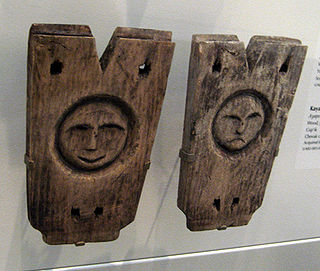
The University of Alaska Museum of the North is housed on the University of Alaska Fairbanks campus.

The following outline is provided as an overview of and topical guide to the U.S. state of Alaska:
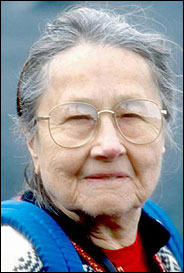
Frederica ("Freddy") Annis Lopez de Leo de Laguna was an American ethnologist, anthropologist, and archaeologist influential for her work on Paleoindian and Alaska Native art and archaeology in the American northwest and Alaska.
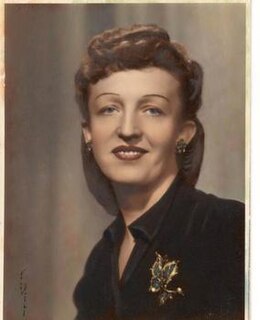
Evangeline Atwood (1906–1987) was an American historian, activist, and philanthropist. She was the co-founder of numerous organizations in Alaska, including the Alaska Statehood Association, the Anchorage League of Voters, the Alaska World Affairs Council, Parent-Teacher Council of Anchorage, and the Cook Inlet Historical Society. In 2009, she was named to the Alaska Women's Hall of Fame. Her husband was Robert Atwood and was the co-owner, alongside him, of the Anchorage Times.
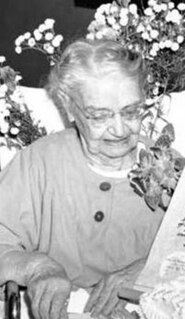
Orah Dee Clark (1875–1965) was an American educator. She was the first superintendent for the first school in Anchorage, Alaska. In 2009, she was named into the Alaska Women's Hall of Fame.
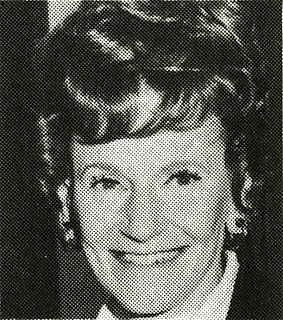
Helen Marie Fischer was an American politician and activist. She fought for Alaska Statehood and women's rights. A Democrat, she served in the Alaska Territorial House of Representatives in 1957-1959 and then the Alaska House of Representatives 1959-1961 and 1971-1975 before and after Alaska became a state. In 2009, she was inaugurated into the Alaska Women's Hall of Fame.
Dorothy Awes Haaland was an American lawyer and politician. She served in the final Alaska Territorial Legislature when Alaska was still the Territory of Alaska. In 2009, she was added to the Alaska Women's Hall of Fame. She was the first woman to be admitted to the Alaska Bar Association.
The Girl from Alaska is a 1942 American western film directed by Nick Grinde and William Witney and starring Ray Middleton, Jean Parker and Jerome Cowan.

Dove Kull (1897-1991) was a social worker from Oklahoma. After a 37-year career in Oklahoma, serving as second-in-command of the Works Progress Administration and later designing the Oklahoma Department of Public Welfare's adoption policies, Kull moved to Alaska and became the first social worker to administer service to Native Alaskans in the Aleutian Islands. She also secured the funds for the first child care center in Alaska and directed the first home-health service for the elderly in the State. She was posthumously inducted into the Alaska Women's Hall of Fame in 2015.














